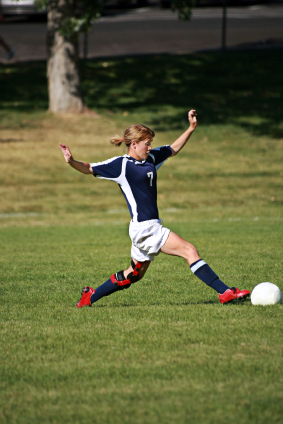The alarming increase in the number of younger children and adolescents suffering ACL (anterior cruciate ligament) injuries playing sports may be the by-product of the trend towards early specialization and year-round play in a single sport.
What's happening is that usually by about age 12, children choose the sport in which they are determined to excel and then participate in that sport year round," explains Darren L. Johnson, MD, orthopaedic surgeon and director of sports medicine at the University of Kentucky School of Medicine.
Downsides to early specialization
"Not long ago our youth participated in multiple sports during the year, which effectively allowed an athlete to cross train and use multiple muscle groups differently and develop to their potential," Dr. Johnson said.
"But nowadays kids are picking one sport by the time they are 13 and playing year round on multiple teams, home and travel, which only allows development of the specific muscle group that applies to that specific sport."
"To play multiple sports is, in the best sense, childlike and fun," says Dr. Johnson. "Specialization at an early age conveys a seriousness of purpose that can lead to burnout, injury, or both, which is common in high school athletes."
"What is amazing when you think about it is that 12- and 13-year old kids will often end up playing more games than athletes competing at the collegiate level. We simply don't know the effect of all that quite yet."
"What is known, though, is that "participating without taking time off, playing on multiple teams at one time and at higher competition levels, makes young athletes more susceptible to ACL tears at a younger age," says Dr. Johnson.
Full recovery not assured
An ACL tear or rupture is a severe injury to the knee, most often requiring surgery to replace the ACL and a lengthy recovery period. Between a half and two-thirds of athletes do not return to their previous level of function with respect to performance, frequency of sports participation, and intensity, without increased risk of further permanent injury to the knee or late irreversible degenerative changes.
To improve the statistics, orthopaedic surgeons are trying to more accurately customize surgery to each individual patient. "We are trying to do a better job at recreating a person's unique anatomy," he says, "to try to recreate the ACL that the patient had prior to the injury."Taking time to fully heal critical
Dr. Johnson advises athletes to give their legs proper time to heal before returning to the sport in which they injured their knee. "This is a year-long recovery, [which] many young athletes don't understand." He points to Tiger Woods as an example.
Woods injured his ACL and only returned to competitive golf after eight months of intensive rehabilitation. "The reason you cannot return to playing after a few months is because you do not have the strength back in your leg and the repaired ligament is not strong enough," said Dr. Johnson.Individualized return-to-play decision
Making the return to play decision after ACL surgery even more difficult is the fact that it must be individualized to the athlete and the sport because not all ACL tears are the same and not all athletes rehab the same. "I would imagine that Tiger Woods, after his ACL surgery put much time and effort into the rehabilitation process than most high school athletes having the same surgery," says Dr. Johnson, and "this clearly has an effect on outcome and return to play. Taking a slow phased-in approach to rehabilitation with appropriate monitoring of athletes as they return to the field is of utmost importance."
Returning too soon risks re-injury
Full recovery before returning to sports is important for another reason: "Coming back too early is a real problem and puts the athlete at a higher risk for re-injury," warns Dr. Johnson. "Having two ACLs replaced by the time athletes are in high school is not uncommon," he notes, "but once that happens, it is very unlikely their knees will ever be normal."








